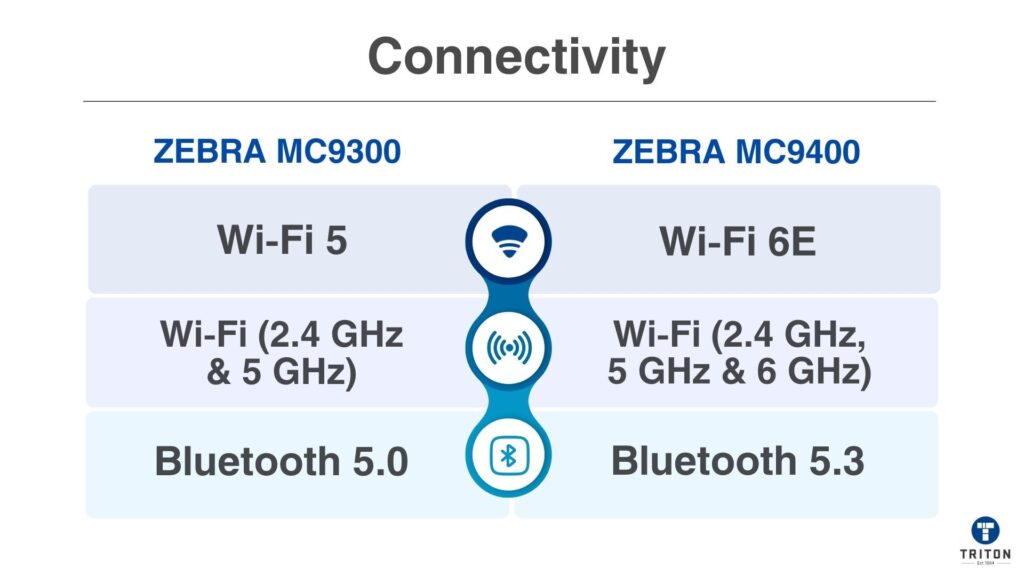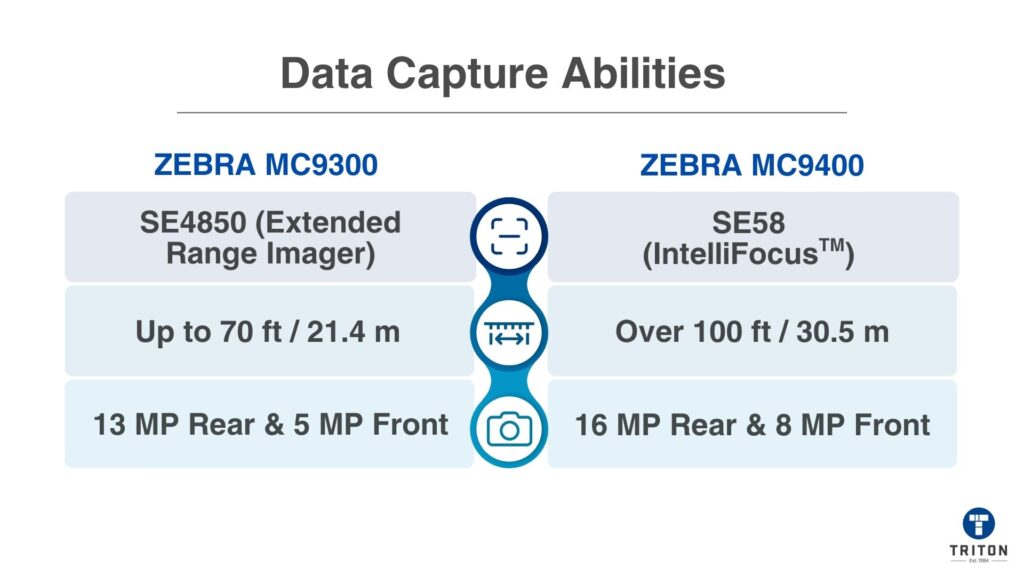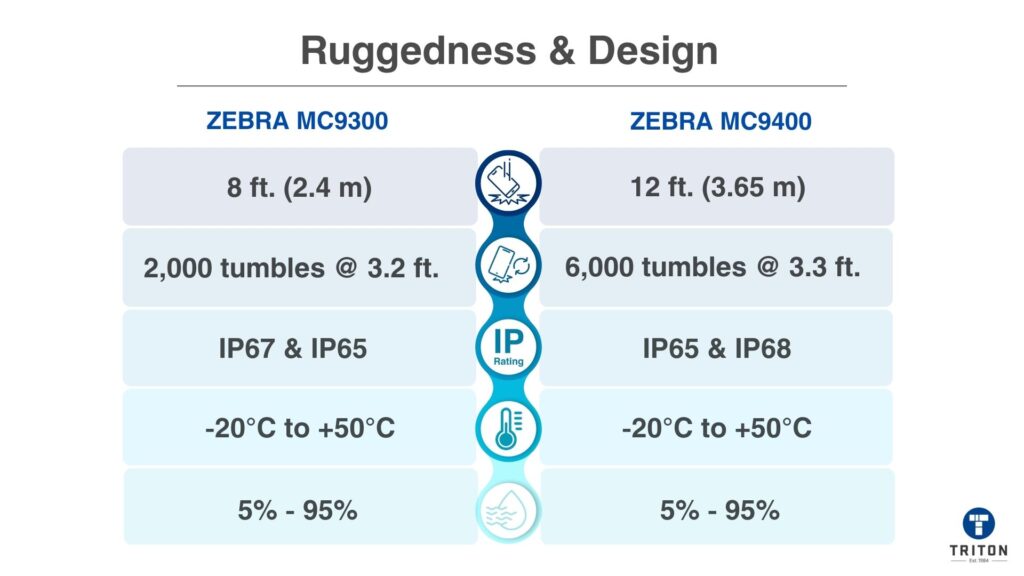
The Zebra MC9000 series is an undisputed industry icon, and many of our customers depend on the powerful and trusted Zebra MC9300 for operational efficiency.
Now, that platform has evolved.
Zebra’s successor, the MC9400/MC9450 series, is a significant technological leap, engineered for the next generation of industrial applications.
It delivers a massive productivity boost, packing next-gen Wi-Fi 6E, 5G data, and 2.5 times more processing power. This analysis breaks down the crucial upgrades, helping you determine if this investment is the right choice to maximise your future performance.
Each generation of the MC9000 series introduced new technology while retaining a core design philosophy for investment protection.
The MC9300 set a high benchmark with a powerful Qualcomm 660 octa-core processor and reliable performance.
The subsequent MC9400/MC9450 series has built upon this foundation by introducing technological advancements. This included a more powerful Qualcomm 4490 processor, next-generation connectivity with Wi-Fi 6E, and optional 5G data for the MC9450.
Data capture capabilities have also been enhanced with the new SE58 Extended Range Scan Engine.
The evolution to MC94XX has maintained full backwards compatibility with MC93XX accessories, which means your business can upgrade to the newer technology cost-effectively by preserving the entire existing investment in MC9300 charging cradles, holsters, handstraps and other accessories.

The MC9400/MC9450’s core processing is 2.5 times more powerful than the MC9300’s, driven by the upgrade to a Sualcomm 4490 processor.
Processor power is complemented by 6 GB of RAM (a 50% increase) and 128 GB of internal Flash storage (a 4x increase). The newer platform also provides a much longer operational lifecycle with an OS upgradeable to Android 17, which is expected to launch in Q2 2026 and will receive support & updates for seven years after that.
The MC9300 runs Android 10 (Q), which Google stopped patching in September 2022. Any Android 10 device without ongoing updates faces unpatched vulnerabilities.
However, Zebra’s LifeGuard for Android backports security fixes well beyond Google’s EOL. MC9300 units enrolled in LifeGuard continue to receive patches for up to ten years from their initial release in April 2029.
Feature | Zebra MC9300 | Zebra MC9400 / MC9450 |
|---|---|---|
CPU | Qualcomm Snapdragon 660 octa-core at 2.2 GHz | Qualcomm 4490 octa-core at 2.4 GHz (2.5x more powerful overall processing) |
OS Support & Lifecycle | Android 8.1 Oreo, upgradable to Android 14; security updates ended early 2023, posing risks for new deployments | Upgradeable to Android 17 |
Memory (RAM) | 4 GB | 6 GB (50% increase) |
Internal Storage (Flash) | 32 GB pSLC | 128 GB Flash (4x increase) |
Storage Expansion | MicroSD slot, supports up to 256 GB SDXC | MicroSD slot, supports up to 2 TB |
The Qualcomm 4490’s 2.5x overall processing power over the Snapdragon 660 comes from factors beyond the slight clock speed increase (2.4 GHz vs. 2.2 GHz for peak cores):
|

The MC9400/MC9450 has introduced the most significant connectivity upgrades in the series’ history, fundamentally changing where and how the scanner can be used.
While the MC9300 is limited to Wi-Fi, the MC9450 adds private and public 5G cellular data. It offers persistent, high-speed connectivity in large outdoor environments like ports and yards where Wi-Fi is impractical.
The upgrade from Wi-Fi 5 (802.11ac) to Wi-Fi 6E unlocks the uncongested 6 GHz band, improving performance in crowded wireless environments. This combination of 5G and Wi-Fi 6E ensures seamless, next-generation speed both inside the four walls and far beyond them.
Feature | Zebra MC9300 | Zebra MC9400 / MC9450 |
|---|---|---|
WLAN (Wi-Fi) | Wi-Fi 5 (IEEE 802.11ac) | Wi-Fi 6E (IEEE 802.11ax) |
Wi-Fi Bands | Dual-Band (2.4 GHz, 5 GHz) – Standard performance for most warehouse tasks. | Tri-Band (2.4 GHz, 5 GHz, 6 GHz) – Access to the exclusive 6 GHz band drastically reduces interference and latency, ideal for data-intensive apps in crowded device environments. |
WWAN (Cellular) | Not Available – Device use is restricted to areas with Wi-Fi coverage. | Enables seamless, high-speed connectivity across expansive outdoor areas like shipping yards, ports, and field service locations without relying on Wi-Fi. |
WPAN (Bluetooth) | Bluetooth 5.0 – Reliable pairing for printers, headsets, etc. | Bluetooth 5.3 with secondary BLE beaconing battery. – More energy-efficient for longer peripheral battery life, more stable connections, and allows device tracking even when powered off (with BLE battery). |
NFC | Tap-to-Pair | Tap-to-Pair |

The MC9300 captures 1D and 2D barcodes with four scan engines: SE965 for standard range, SE4750 for omnidirectional imaging, SE4750 DPM for direct part mark and SE4850 for extended range up to 21 m.
The MC9400 adds the SE58 IntelliFocus™ engine for scans from hand-held to over 30 m and retains the SE4770 with red laser.
This new engine extends the maximum scanning distance of the MC9400/MC9450 series to over 100 feet – a meaningful increase from the MC9300’s 70-foot range – and incorporates a green laser aimer seven times more visible than the previous red dot, which makes targeting distant barcodes on high warehouse racks faster and more accurate.
The camera system has also been upgraded to a 16MP rear camera with HDR and an 8MP front camera for higher-quality imaging and video collaboration.
Finally, the new series adds modern data capture methods unavailable on the MC9300, including biometric facial recognition for secure login and an OCR Wedge for automated text capture.
Feature | Zebra MC9300 | Zebra MC9400 / MC9450 |
|---|---|---|
Scan Engine | SE4850 Extended Range Imager | SE58 Extended Range Scan Engine with IntelliFocus™ |
Max Scan Range | Up to 70 ft / 21.4 m
Effective for most multi-level warehouse racks.
| Over 100 ft / 30.5 m
Allows workers to scan the highest racks without leaving their vehicles, saving time and improving safety.
|
Aimer Technology | Standard Red Dot Aimer
Functional in typical indoor lighting.
| High-Visibility Green Laser Aimer
Up to 7x more visible, making it dramatically easier to target barcodes from a distance, even in bright sunlight.
|
Rear Camera | 13 MP Autofocus
Sufficient for basic proof-of-condition photos.
| 16 MP Autofocus with HDR
Produces clearer, more detailed images for documenting damaged goods or quality checks.
|
Front Camera | 5 MP Fixed Focus
Provides basic video call capability.
| 8 MP
Enhances video collaboration and enables other camera-based applications.
|
New Capture Methods | Not Available
Relies on manual password/PIN entry for security.
| Biometric Facial Recognition, OCR Wedge
Facial recognition provides faster, more secure device access, while OCR automates text capture to reduce manual entry errors.
|

The MC9000 series has always been known for being a brick, but Zebra seriously upped the ante with the MC9400. Let’s start with drop protection, because these things will inevitably get dropped. The MC9300 could handle an 8-foot fall to concrete, which is solid. The new MC9400, though, can survive a 12-foot drop.
That’s not just a small jump; that’s the difference between falling off a workbench and taking a tumble from a high ladder.
Then there’s the relentless, day-in, day-out wear and tear. Zebra simulates this with a tumble test; the numbers here are stark. The MC9300 was rated for 2,000 tumbles. The MC9400 is built to withstand 6,000 tumbles. It’s engineered to take three times the daily beatings of the model it replaces.
And what about water and dust? Both are sealed tight. The MC9300 has an excellent IP67 rating, meaning it can be submerged. The MC9400 improves on this with an IP68 rating, giving you extra peace of mind if it takes a deeper or longer plunge.
Of course, some things didn’t need changing.
Both models still use super tough Corning® Gorilla® Glass on the two most vulnerable spots: the display and the scanner window. And if you work in extreme cold or around hazardous materials, you can still get the specialised freezer and non-incendive models for both series.
Feature | Zebra MC9300 | Zebra MC9400 / MC9450 |
|---|---|---|
Drop Specification | Multiple 8 ft. (2.4 m) drops to concrete at room temperature per MIL-STD-810G; multiple 6 ft. (1.8 m) drops across operating temp range | Exceeds MIL-STD-810H: 12 ft. (3.65 m) to concrete; enterprise standard 8 ft. (2.4 m) to concrete; freezer version: 7 ft. (2.1 m) to concrete |
Tumble Specification | 2,000 tumbles @ 3.2 ft. (1 m) (4,000 hits); meets/exceeds IEC | 6,000 tumbles @ 3.3 ft. (1 m); meets/exceeds IEC |
Sealing (IP Rating) | IP67 and IP65 | IP65 and IP68 |
Vibration | 4 g’s PK Sine (5 Hz-2 kHz); 0.04 g²/Hz Random (20 Hz-2 kHz), 60 min/axis, 3 axis | 4 g’s PK Sine (5 Hz-2 kHz); 0.04 g²/Hz Random (20 Hz-2 kHz), 60 min/axis, 3 axis |
Electrostatic Discharge (ESD) | ± 15 kVdc air discharge; ± 8 kVdc direct discharge; ± 8 kVdc indirect discharge | ± 15 kV air discharge; ± 8 kV direct discharge; ± 8 kV indirect discharge
|
Operating Temperature | Standard: -20 °C to +50 °C; Cold storage: -30 °C to +50 °C | Standard: -20 °C to +50 °C; Freezer: -30 °C to +50 °C |
Storage Temperature | -40 °C to +70 °C | -40 °C to +70 °C |
Humidity | Standard: 5%-95% non-condensing; Cold storage: 5%-95% condensing | Standard: 5%-95% non-condensing; Freezer: 5%-95% condensing |
Thermal Shock | -40 °C to +70 °C rapid transition | Not Specified |
Protective Glass | Corning® Gorilla® Glass | Corning® Gorilla® Glass |
Specialty Models | Cold Storage; Non-Incendive (Class 1 Div 2) | Freezer; Non-Incendive (Class 1 Div 2) |
A scanner isn’t just about the hardware – the software is what makes it work well or turns it into a hassle. That’s why Zebra’s Mobility DNA suite matters so much. It’s a set of apps and tools built on Android to handle everyday business issues, and it adds a ton of value to both the MC9300 and MC9400.
Upgrading hardware often means dealing with old apps that might not fit anymore. If your setup uses those classic “green screen” terminal emulation (TE) apps, both models have you covered.
They run them straight from the start, without tweaking the backend or teaching your team something new. The MC9400 has the Ivanti All-Touch TE installed and licensed, so you don’t have to pay extra to keep things going.
Both models use LifeGuard™ for Android™ to deliver steady security updates that protect your data over the long haul. This stands out more on the MC9400 because of its extended support to Android 17.
The MC9400 also provides a handy fix for losing devices in busy spots like warehouses. Its BLE-enabled battery lets the Device Tracker find a unit even if switched off or drained. That could reduce the costs of missing equipment.
Mobility DNA throws in some practical free tools along with the main stuff. Both scanners include PTT Express to let them act like walkie-talkies over Wi-Fi, without any added charges. You get diagnostics to keep Wi-Fi running smoothly, plus controls to secure the device by limiting certain Google services for better privacy.
Feature / Tool | Zebra MC9300 | Zebra MC9400 / MC9450 |
|---|---|---|
Legacy App Support | Supports Terminal Emulation (TE) apps out of the box. | Comes pre-loaded and pre-licensed with Ivanti All-Touch TE. |
Security Updates | LifeGuard™ for Android™ with support concluding at Android Q. | LifeGuard™ for Android™ with an upgrade path through Android 17. |
Device Communication | Pre-loaded and pre-licensed PTT Express for push-to-talk over Wi-Fi. | Supports Workcloud Communication™ PTT Express and PTT Pro. |
Device Location | Standard network and sensor-based locationing support. | Enhanced Device Tracker support using the optional BLE battery to find devices even when powered off. |
Wi-Fi Management | Includes WorryFree WiFi, a tool for network diagnostics and performance. | Includes advanced analytics and diagnostics for the newer Wi-Fi 6E radio. |
OS Control | Zebra’s Restricted Mode provides control over Google Mobile Services (GMS). | Control over GMS plus over 100 enterprise features via Mobility Extensions (Mx) |
After all the specs and features, you must decide where to spend your money.
Let’s be clear: the MC9300 is no slouch. It’s still a compelling and rugged device that does the job for thousands of businesses.
Sticking with the MC9300, or buying it now, is a smart financial move if your operation is mainly contained within four walls with reliable Wi-Fi. If your current apps run fine and your workers don’t need to scan barcodes from the rafters over 70 feet away, then the MC9300 is a proven workhorse that will serve you well.
When does spending the extra money on an MC9400 make sense?
Consider the following scenarios.
No one likes spending more money than they have to. The MC9400 has a higher price tag, but the total ownership cost might be lower.
Its superior durability means fewer repairs and replacements.
Finding lost devices even when they’re off saves a fortune. And because you can reuse all your old MC9300 accessories, the financial hit from upgrading is softened considerably. You’re not just buying a faster scanner but investing in a more resilient and future-proof platform.
Whatever your requirements, Triton can equip your team with the right tools for the job.
Ready to upgrade your operations?
If you have more questions or need help deciding, our team of experts is ready to assist.
Christmas and New Years Hours
🎉 Happy Holidays from all of us at Triton Store! 🌟
As we bid farewell to another amazing year, we’re taking a short break to recharge and celebrate with our loved ones. Our store will be on a holiday pause from 23rd December until 12th January.
But worry not! You can still place your orders during this period, and we’ll be ready to spring into action and process and ship them promptly starting 12th January.
We appreciate your understanding and can’t wait to serve you in the new year. Here’s to a fantastic holiday season and a brilliant start to the new year! 🥳